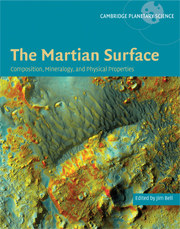Book contents
- Frontmatter
- Contents
- List of contributors
- Foreword
- Acknowledgments
- Part I Introduction and historical perspective
- Part II Elemental Composition: Orbital and in situ Surface Measurements
- Part III Mineralogy and Remote Sensing of Rocks, Soil, Dust, and Ices
- Part IV Physical Properties of Surface Materials
- 18 The thermal inertia of the surface of Mars
- 19 Physical properties of the Martian surface from spectrophotometric observations
- 20 In situ observations of the physical properties of the Martian surface
- 21 Martian surface properties from joint analysis of orbital, Earth-based, and surface observations
- Part V Synthesis
- Part VI Summary, Upcoming Missions, and New Measurement Needs
- Index
- Plate section
- References
19 - Physical properties of the Martian surface from spectrophotometric observations
from Part IV - Physical Properties of Surface Materials
Published online by Cambridge University Press: 10 December 2009
- Frontmatter
- Contents
- List of contributors
- Foreword
- Acknowledgments
- Part I Introduction and historical perspective
- Part II Elemental Composition: Orbital and in situ Surface Measurements
- Part III Mineralogy and Remote Sensing of Rocks, Soil, Dust, and Ices
- Part IV Physical Properties of Surface Materials
- 18 The thermal inertia of the surface of Mars
- 19 Physical properties of the Martian surface from spectrophotometric observations
- 20 In situ observations of the physical properties of the Martian surface
- 21 Martian surface properties from joint analysis of orbital, Earth-based, and surface observations
- Part V Synthesis
- Part VI Summary, Upcoming Missions, and New Measurement Needs
- Index
- Plate section
- References
Summary
ABSTRACT
The reflection of visible and near-infrared light from Mars can vary significantly depending on the directional scattering characteristics of surface materials. Observations acquired under a range of illumination and viewing angles can be input to radiative transfer models to constrain the albedo, surface roughness, grain size, and/or porosity of these materials. This chapter reviews multiangular measurements of Mars obtained by Earth-based telescopes (including the Hubble Space Telescope), orbiters (Mariner, Viking, Mars Express), landers (Viking, Mars Pathfinder), and rovers (Mars Exploration Rovers), and how the photometric analyses of these datasets have been used to understand the surface properties of local and regional geologic units and terrain types. Although acquisition of data covering sufficient incidence, emission, or phase angles to fully constrain all parameters within photometric models is challenging, a common theme among these studies is the dominantly backscattering nature of the Martian surface, the magnitude of which is often related to the presence of high-albedo aeolian dust. The local and regional photometric variability observed in these data encourages further refinement of radiative transfer methods and atmospheric correction algorithms to provide additional tools with which to categorize and map distinct photometric units on Mars, particularly to provide support for ongoing and upcoming orbital and landed missions.
- Type
- Chapter
- Information
- The Martian SurfaceComposition, Mineralogy and Physical Properties, pp. 428 - 450Publisher: Cambridge University PressPrint publication year: 2008
References
- 7
- Cited by

